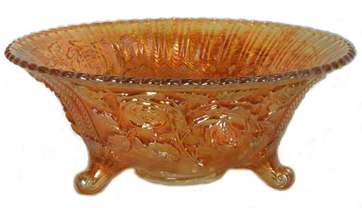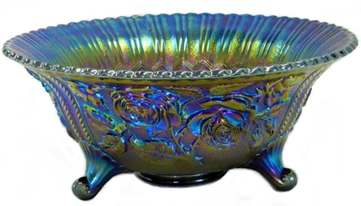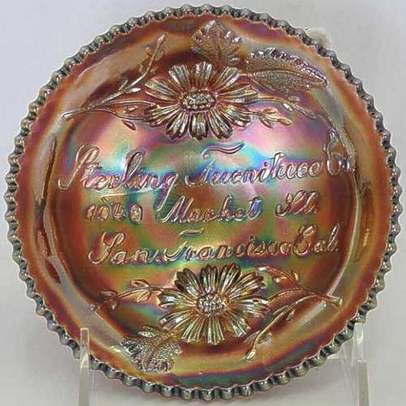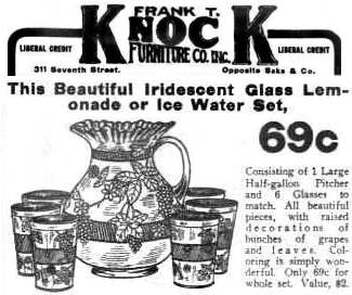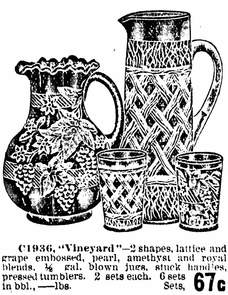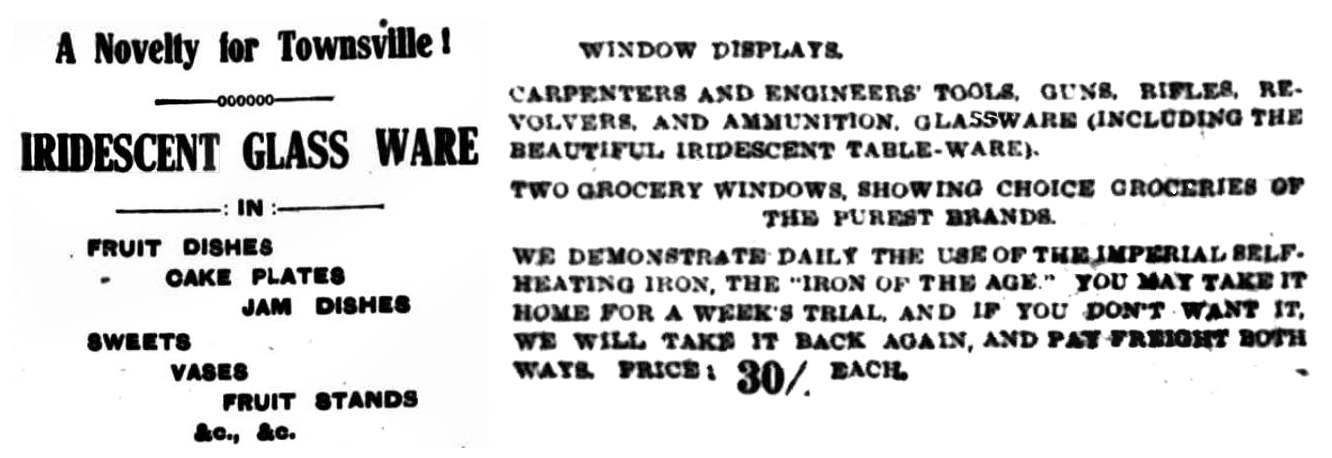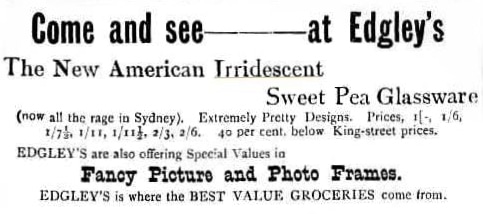Sell Me Some Carnival Glass: Part Two
In Part One of Sell Me Some Carnival Glass, we looked at sales in Drug Stores and Hardware Stores. Here, in Part Two, we are concentrating on Furniture Stores, General Stores and Grocery Stores.
Furniture Stores
Carnival Glass was often an inducement that was used to generate sales at the furniture stores. The 1912 ad (below, right) shows a magnificent Lustre Rose footed berry bowl that was offered for just five cents (described as “practically a ‘give-away’ price”) to the shoppers at the wonderfully named Greater Hub Furniture Co. in Washington.
Carnival Glass was often an inducement that was used to generate sales at the furniture stores. The 1912 ad (below, right) shows a magnificent Lustre Rose footed berry bowl that was offered for just five cents (described as “practically a ‘give-away’ price”) to the shoppers at the wonderfully named Greater Hub Furniture Co. in Washington.
|
Lustre Rose bowls were chosen as the “Special Opening Souvenir” for the Hub’s grand opening, and it appears that they were popular! Clearly the store ran out of stocks on the opening day and they had to get hold of more supplies, hence the by-line in this ad for “Those Who Were Not Supplied Saturday”. Imperial's Lustre Rose bowls in marigold (above) and purple (below).
Courtesy of Seeck Auctions |
|
Sterling Furniture Co., San Francisco
A specific, and very desirable genre of Carnival Glass pieces are referred to by collectors as Lettered Pieces, which embrace Advertising / Promotional Pieces and Souvenir Pieces. There is much more information about many of these pieces here: Advertising, Souvenir and Commemorative Carnival Glass. Below, we have an example of such a promotional piece made by Fenton - they used their "blank" Garden Mums design and added the specific lettering for Sterling Furniture Co. Interestingly on the right, we can also show an ad from 1909 for the very same furniture company: it was placed in the San Francisco Call newspaper. Note how the ad uses some of the sales techniques we have reported on elsewhere: a time limited offer (it was only available for 2 hours on a Saturday morning), and available to personal shoppers only (no mail or phone orders allowed). Note also the reference to imitation Tiffany that was also a regular advertising temptation! Although the company turned to Fenton for their Sterling Furniture promotional bowl, this 1909 ad shows they were also selling Carnival made by Northwood. The ad shows a Thin Rib vase: the artist has taken full licence to interpret the vase freely, as the number of ribs/flutes is not illustrated with precision and accuracy on the drawing of the vase. An amethyst Sterling Furniture small bowl (on a Garden Mums design).
Fenton. Rare. Courtesy of Seek Auctions. |
This ad (below, left) from the 1912 Washington Herald is for the Frank T Knock Furniture Co. Inc. and it provides a fascinating insight into the mark-up on sales of Carnival Glass. Frank T Knock was retailing a Dugan Floral and Grape water set, claimed to be "Value $2" for only 69 cents, but an ad in the same year shows that the Butler Brothers wholesale price was 67 cents for 12 sets. That's a pretty good mark-up by any standard! On the right is a purple Dugan Floral and Grape water set, courtesy of Seeck Auctions.
Both Dugan and Fenton made water sets in the Floral and Grape pattern. The way to identify the Dugan pitchers from the ones made by Fenton is to look at the central band of diagonal lines around the pitcher: if they lean to the left, it's Dugan, and if they lean to the right, it's Fenton. The Butler Brothers ad in the centre above confirms this. Butler Brothers were known to offer items from the same maker in such ads - so, as we know Grapevine Lattice was a Dugan item, it follows that the Floral and Grape pitcher was also a Dugan piece, with left-leaning diagonal lines in the band.
|
General Stores and Grocery Stores
The General Store would usually have served a small community, selling more or less anything and everything, including Carnival. Similarly, Grocery Stores, selling food and general provisions, often had special promotions of glassware, including the well-known Baking Powder give-aways, so they were likely places for Carnival Glass to be sold. Above: the composite ad above is from the Townsville Daily Bulletin
(in Queensland, Australia). It is for Hollimans General Store in 1916, where among the window displays of guns, rifles, ammunition and carpenter’s tools, you would have found an entire range of Carnival Glass! |
A typical General Store of the Carnival Glass era.
Library of Congress image. |
|
Above: an ad for Edgley's Grocery Store, Bathurst, Australia in 1910
|
Left: Carnival Glass was on offer at Edgley's, Grocery Store in Bathurst, Australia (some 100 miles west of Sydney) where the local paper ran this intriguing ad in 1910 for “The New American Irridescent (sic) Sweet Pea Glassware”. The range of prices quoted in the ad suggests there were various shapes and sizes of items on offer. This is the first time we have seen Carnival described as “Sweet Pea Glassware”. The comment that it is “now all the rage in Sydney” is wonderfully informative. |
In Part One, we looked at Drug Stores and Ironmongers
In Part Three, we look at Drapery Stores, Five & Ten Cents Stores, and China and Glassware Stores
In Part One, we looked at Drug Stores and Ironmongers
In Part Three, we look at Drapery Stores, Five & Ten Cents Stores, and China and Glassware Stores
